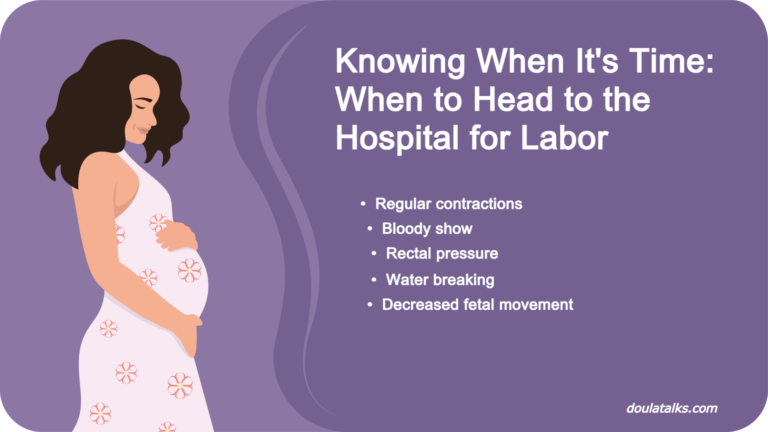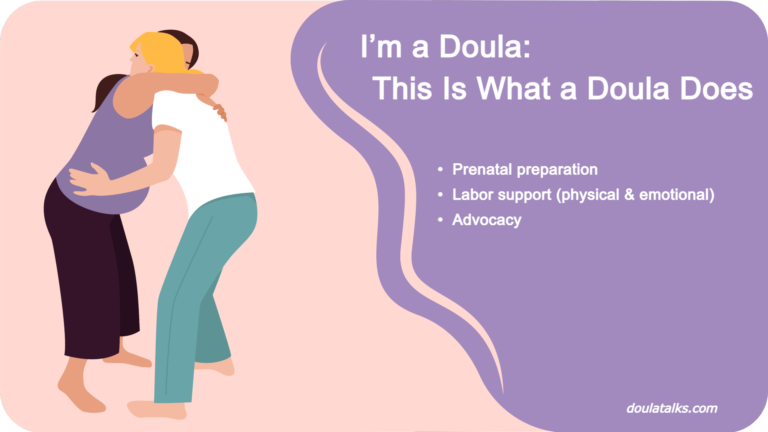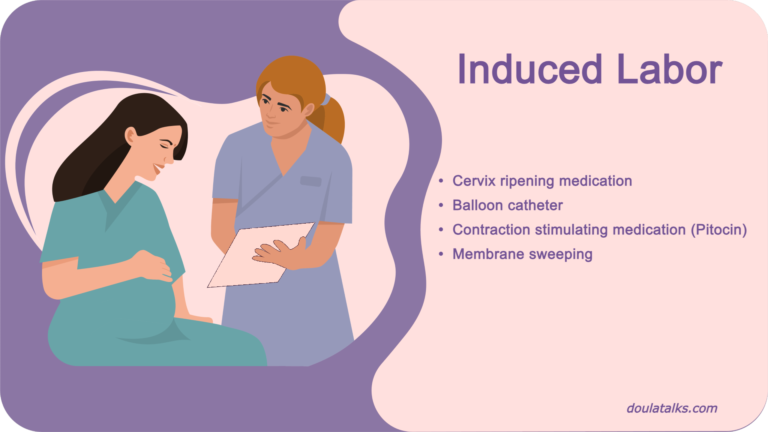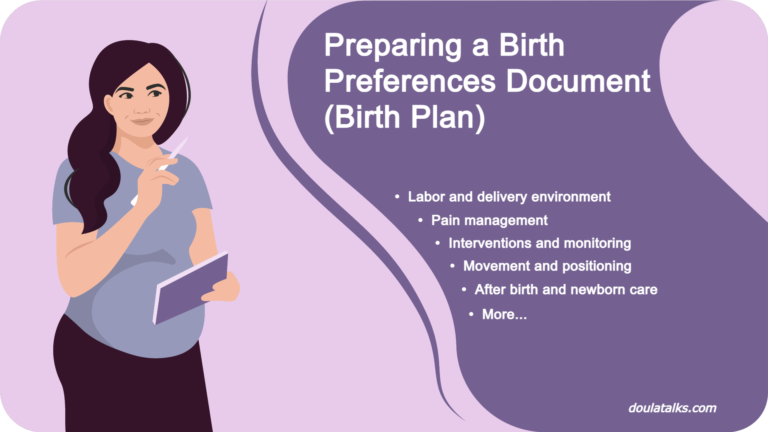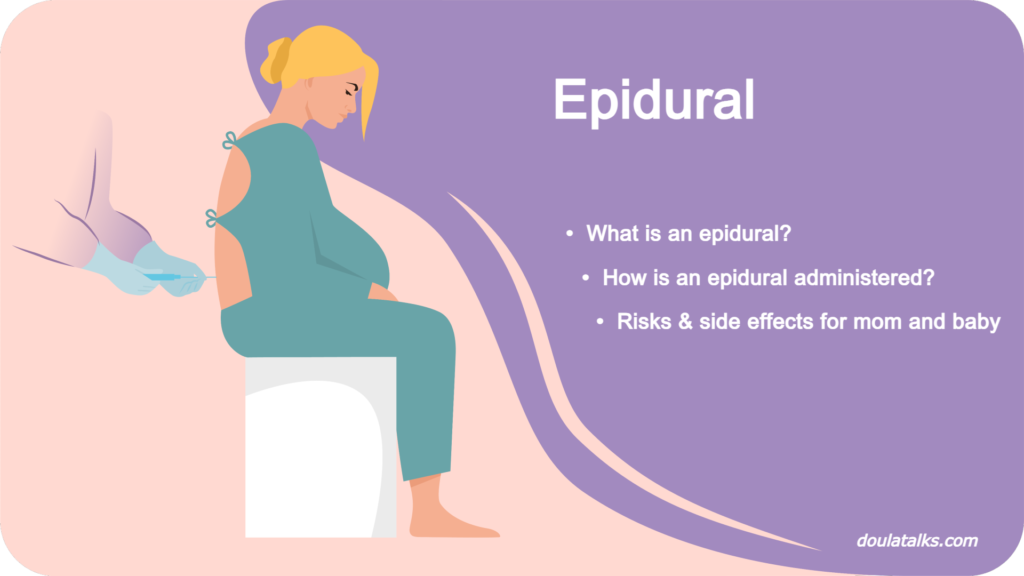In This Article:
Hearing the words “pain medication” and “epidural” usually prompts a lot of emotional reactions.
Some women feel that it is an achievement to give birth without using pain medication at all, and get disappointed in themselves and feel that they are giving up if they end up asking for pain relief.
I personally feel that pain medications, including epidural, are simply tools. The decision to use or not use them should be made after reviewing and considering all the information. Also, I feel that women are allowed to change their minds during birth (in either direction) without being judged or criticized.
It’s important to remember that labor pain is a natural and normal part of the childbirth process. Each woman’s experience of pain during labor is unique, and there is no right or wrong way to manage it. The intensity of labor pain can vary greatly from woman to woman — and even from one labor to another.
One of the most effective and widely used forms of pain relief during childbirth is an epidural, which involves the administration of a local anesthetic into the epidural space of the spine. This results in numbness in the lower body and can significantly reduce the intensity of pain during labor. However, epidural has some potential risks and side effects, so it should be discussed with a healthcare provider and considered carefully before use.
Also, it is important to note that an epidural may not be appropriate or effective for every woman. Some women may have medical conditions or complications that make an epidural contraindicated.
Let’s explore the different questions that might come up when considering an epidural during childbirth.
How is an epidural administered?
Most people refer to epidural as a medication, but, in fact, the epidural space is the area between the spine and the outermost layer of the spinal canal, located in the lower back, aka lumbar spine region. It contains the nerves that transmit pain signals from the uterus and birth canal to the brain.
The actual medication contains a combination of an anesthetic and an opioid.
The procedure for administering an epidural begins with the woman sitting up and leaning forward or lying on her side. The anesthesiologist will clean the skin on the lower back and inject a small amount of local anesthetic to numb the area. They will then insert a needle into the epidural space and thread a tiny, flexible catheter through the needle. The needle is then removed, leaving the catheter in place. The medication is delivered through the catheter using a pump, which allows the woman to receive a continuous dose of pain relief. Some women are concerned about the size of the needle or the pain involved in inserting the catheter. The needle is a normal-size needle and once the skin is numb, you should not feel pain when the epidural is placed. It is normal to feel some light pressure in the back as the doctor inserts the needle and catheter, and sometimes a small zing in one of the legs.
The epidural usually takes effect within 15 to 20 minutes, and the level of pain relief can be adjusted by the anesthesiologist. The epidural medication typically lasts for the duration of labor and delivery, although some women may require additional doses.
At what stage of labor is an epidural given?
An epidural is typically administered during active labor, which is the stage of labor when the cervix is dilated to at least 4 to 5 centimeters, and regular contractions have begun. Some women may choose to have an epidural early on in labor, while others may wait until the contractions become more intense and frequent. When using it earlier, there is a risk of contractions spacing out, which could require a need to start adding Pitocin to encourage contractions to become regular.
Also Read:
How long does labor with an epidural last?
On average, labor with an epidural can last longer than without an epidural.
However, the impact of an epidural on labor length can vary depending on individual circumstances and medical practices, including the individual woman’s labor progress and the stage of labor in which it was administered.
Some studies have suggested that the use of an epidural may increase the likelihood of needing interventions such as vacuum-assisted delivery or cesarean section, which can also impact the length of labor. There are instances where an epidural may have a positive effect on labor and help relax the pelvis, which may prompt quicker progress.
Sometimes an epidural may be turned off when it is time to push to help the mother regain sensation and push more effectively.
Does an epidural make you dilate faster?
There is no clear consensus on whether an epidural makes you dilate faster during labor. Some studies have suggested that an epidural can slow down the process of cervical dilation, while others have found no significant impact on dilation.
One possible reason for the conflicting results is that an epidural can affect the body in different ways, depending on the dosage of medication and individual circumstances. For example, a lower dosage of medication may allow for more movement and sensation, which could potentially help the cervix dilate more quickly. However, a higher dosage of medication may cause more numbness and less mobility, which could potentially slow down the process of dilation.
It is also important to note that the process of labor and delivery is complex and can be influenced by many different factors, including the position of the baby, the strength and timing of contractions, and the individual woman’s physical and emotional state.
Does labor still hurt with an epidural?
While an epidural can significantly reduce the pain and discomfort of labor, it does not eliminate all sensation or pain. Many women still feel some pressure and mild discomfort during labor and delivery—even with an epidural. Some women may still feel pain on one side of the body and not the other.
The level of pain relief provided by an epidural also can vary depending on individual factors, such as the dosage of medication and the position of the baby. In some cases, an epidural may not provide complete pain relief or may wear off during labor, which can result in increased discomfort or the need for additional pain relief.
Can you walk after an epidural?
Epidural impacts mobility and sensation in the lower part of the body. It is common to feel numb or heavy in the legs after receiving an epidural, which can make it difficult to walk or move around.
Most women can walk unassisted within a few hours after giving birth, once the epidural has worn off and sensation has returned. However, some women may experience lingering numbness or weakness in the legs for a period after delivery, which can impact mobility.
Epidural risks and side effects to mother and baby
While epidural can provide significant pain relief during labor and delivery, it also has risks and side effects for both the mother and the baby. Some of these include:
For the mother:
Drop in blood pressure
An epidural can cause a drop in blood pressure, which can lead to dizziness, nausea, and, in severe cases, a decreased blood flow to the baby.
Cerebrospinal fluid leak, and headache
A small percentage of women may experience a headache after receiving an epidural, caused by a leakage of spinal fluid. If this were to occur, there is a repair procedure for this called a blood patch.
Back pain
Some women may experience back pain at the site of the epidural injection.
Prolonged labor
In some cases, the use of an epidural can lead to a longer labor and a higher likelihood of instrumental deliveries, such as vacuum extraction or forceps delivery.
Difficulty pushing
The use of an epidural can also make it more difficult to push during delivery, potentially leading to an assisted delivery or cesarean section.
For the baby:
Fetal distress
In rare cases, the use of an epidural can cause the baby’s heart rate to slow down, which can be a sign of fetal distress.
Difficulty latching
Some babies may have difficulty latching onto the breast after birth, potentially due to the use of an epidural.
Feeding problems
In some cases, the use of an epidural can impact a baby’s ability to suck and swallow properly, leading to feeding difficulties.
Conclusion
Epidural anesthesia is a widely used method for managing labor pain and is highly effective in providing relief to the mother. It allows the mother to be alert and present during the childbirth process and has been found to have little adverse effects on the health of the baby. However, it is important to discuss the procedure with a healthcare provider and consider your individual circumstances to make an informed decision about pain management during labor.
I wish you a wonderful and happy labor!
Questions?
If you have any questions about this topic/article, please feel free to contact me through email at: liat@doulatalks.com
Liat Salomon is a certified doula since 2010 and is working in the San Francisco Bay Area in California. She has assisted in hundreds of births and has extensive experience with VBAC.
The information in this article does not constitute medical advice or diagnosis. It is meant for informational purposes only.
Related Articles:





